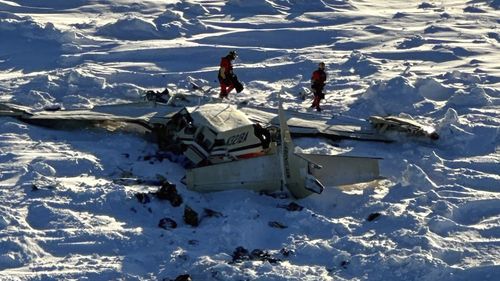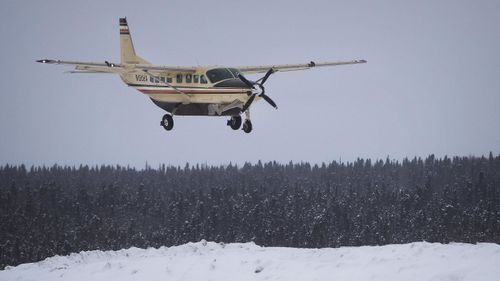All 10 victims of the fatal Alaska plane crash have been recovered and identified, officials say.
All 10 people killed when a regional airline flight crashed off the coast of western Alaska have been recovered and identified, authorities said on Saturday.
“All ten individuals aboard the Bering Air plane have been officially brought home,” the Nome Volunteer Fire Department said in a Facebook post Saturday night.
“Nome SAR efforts stand by for our Bering Air crew to complete their aircraft recovery operations.”

The small commuter aircraft carrying nine passengers and one pilot took off from Unalakleet on Thursday afternoon before disappearing.
The plane was later found on Friday about 54km southeast of Nome, the flight’s intended destination, according to the US Coast Guard.
All 10 on board were declared dead.
The pilot of the plane was 34-year-old Chad Antill of Nome, while the passengers were identified by Alaska State Troopers as Liane Ryan, 52; Donnell Erickson, 58; Andrew Gonzalez, 30; Kameron Hartvigson, 41; Rhone Baumgartner, 46; Jadee Moncur, 52; Ian Hofmann, 45; Talaluk Katchatag, 34; and Carol Mooers, 48.
The wreckage is currently resting on sea ice that officials described as young and unstable, and heavy snow and winds in the area are expected this weekend.
The bodies were the first be recovered, then the plane will be taken for further analysis, officials said.
“We don’t know how long that’s going to take. It could go hours; it could go potentially days. Coming up to tomorrow we have 18 hours of potential recovery time,” Jim West, chief of the Nome Volunteer Fire Department, said at a news conference on Friday night, citing the ever-changing conditions of the crash’s site and incoming weather.
A winter weather advisory is now in effect until 9pm Sunday (local time), with blowing snow, rain and mixed precipitation to be expected in Nome and other parts of western Alaska, the National Weather Service announced.
Some areas may see up to five inches of snow, with ice accumulations of around a tenth of an inch, the NWS said.
Wind gusts as high as 73km/hour will also be recorded.
“The conditions out there are dynamic, so we’ve got to do it safely and the fastest we can,” he added.

Learning how the accident unfolded
Investigators are working to determine the cause of the crash –– and how the aircraft suddenly dropped in elevation and speed.
Analysing air traffic control data will be key to the National Transportation Safety Board’s probe, officials said.
The NTSB has nine people working on the ground along with a dozen specialists supporting them back in Washington, DC, NTSB Chair Jennifer Homendy said at a Saturday news conference.
“Please understand there’s some difficult conditions, because this is on an ice floe, which is moving about five miles a day,” she added.
The Cessna aircraft, operated by Bering Air, was about 19km offshore when its position was lost, according to the Coast Guard.
The aircraft “experienced some kind of event which caused them to experience a rapid loss in elevation and a rapid loss in speed” around 3.18pm Thursday, Coast Guard Lt. Commander Benjamin McIntyre-Coble said.
The search for the aircraft had been complicated by multiple factors, including inclement weather as well as the missing plane had not communicated its position through an emergency transmitter, officials said.
Visibility was better for searchers on Friday morning:
The sky was clear at Nome Airport around 10am, with temperatures of around -15 degrees.
The National Guard and Coast Guard added helicopter search teams to the effort Friday morning, while another Coast Guard C-130 landed in Nome to assist with the search, the fire department said.
A small community accustomed to flying mourns
At a vigil hosted by the city of Nome on Friday, Amanda Snyder, pastor at Our Savior’s Lutheran Church, urged those in attendance to lean on each other for support.
“Please do not isolate yourself in your grief. In the coming days, in the weeks, as we begin to hear of which families are impacted, our hearts are going to break over and over, and it’s okay to mourn and grief, but please do not isolate,” Snyder said.
“Words can’t express the loss we’re all feeling, we’re all connected in so many ways,” said Alaska Sen. Lisa Murkowski, who joined the vigil via video conference.
“It’s hard to accept the reality of our loss.”
It is not unusual for Alaskans to travel between places by small plane due to the vast landscape and lack of transportation infrastructure available.
“It’s just heartbreaking. Because every single person in this room has been on one of those planes,” Snyder told The Nome Nugget, the city’s local paper.
“It hits home.”
Rhone Baumgartner and Kameron Hartvigson were two employees from Alaska Native Tribal Health Consortium who travelled to Unalakleet “to service a heat recovery system that is critical to the community’s water plant,” the nonprofit said on Friday night.
“Rhone Baumgartner and Kameron Hartvigson were passionate about the work they did, cared deeply for the communities they served, and made a lasting impact on rural communities across our state,” Natasha Singh, ANTHC interim president and CEO, said in a statement.
“They were the best at what they did and had just flown into Unalakleet to help address heating and mechanical issues in the depths of winter.
They gave the ultimate sacrifice for the people we serve in the work we do.”
Homendy said she understands how tragic the crash is to the area.
“The NTSB knows that villages like Nome and Alaska aviation are tight-knit communities, so this tragedy affects so many,” she said on Saturday.
“Please know that we’ll work diligently to determine how this happened, with the ultimate goal of improving safety here in Alaska and across the United States.”

